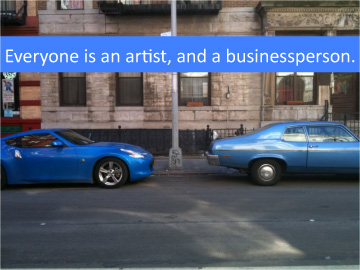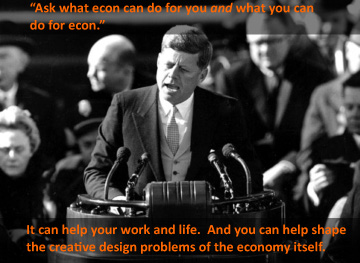I am so pleased to be a new guest blogger at Art21. We were encouraged to introduce ourselves in our first blog post, and so I thought I would write about art and economics. . . .
In 2004, Daniel H. Pink wrote in the Harvard Business Review:
The MFA is the new MBA!
It was number 9 on the list of breakthrough business ideas of 2004.
James J. Cramer—the television host I associate with loudness and a Daily Show sparring match on par with wrestling trash talk of the ‘80s— tackled the same topic around the same time in New York magazine. He wrote, “Analysts need fine-arts degrees. Like the modernists, they need to think creatively, think outside the walls of the 10-Q filing!” Cramer argued that this would help traders, like all great artists before, to foresee the opportunity to buy underrated AT&T stock that would double in value two days later.
At the time, I was receiving an MFA in painting after already having an MBA. Reading the articles, I felt like a guinea pig in the wild, who happened to be accidentally replicating the lab experiment that followed from the hypotheticals they put forth.
MBA-MFA thinking seems to be making a comeback:
In March, Steve Blank wrote on his blog that “Entrepreneurship is an art not a job.”
Last year, John Maeda, the RISD President, coined the term “artrepreneur,” offering RISD graduates Artrepreneur Starter Kits. (When I asked, John said the term has existed for some time and he resurrected it, like a found object.)
In 2008, Katherine Bell, a senior editor at Harvard Business Review issued an “HBR IdeaCast” titled “The MFA is the new MBA.”
New York Foundation for the Arts now offers an “Artist as Entrepreneur Bootcamp.” Creative Capital and the Lower Manhattan Cultural Council jointly run an Artists Summer Institute which is also a business bootcamp. And California College of the Arts offers a “Design Strategy MBA,” to my knowledge the first and only MBA within an art school (and where I teach the core economics class each fall).
From the other side of the conversation, last month, I received a newsletter from Gotham Writer’s Workshop, where I take a class for fun. The lead essay by Jacob Appel painted a picture of the “All-MFA Society.”
I really like it. But what exactly does all this mean?
Joseph Beuys famously said that everyone is an artist. Even though the statement is funny coming from someone whose artistic practice was as democratically available as the decision to lock yourself in a room with a coyote, I think he is right. Everyone is an artist, but everyone is a businessperson too. Creativity is a basic human birthright, but we also live in one of the greatest market economies of all time.
When I was actually getting an MFA, it never felt like a newer, shinier version of an MBA. If anything, understanding opportunity cost—even thinking about time efficiency as a value as the MBA had taught me to do—felt like a crippling way to venture into the unknown of making art. At the beginning of art school, I occasionally felt like a social pariah who was viewed as a rapacious capitalist. I owned a gray interview suit that was not a costume, though perhaps even more controversially, I made traditional oil paintings.
But then I started teaching economics to my classmates. Bruce McLean, the pithy Scottish painter who was the head of our program, made us all give talks about “the ideas behind your art.” He seemed secretly (or not so secretly) to be waging battle against stereotypes of artists as poor public speakers. By the third go-round, I talked about two questions: “What does art have to do with business? And what does art have to do with politics?”
 Waxing poetic about the time value of money to a poker-faced, impervious crowd, I couldn’t tell if people were interested, confused, or offended. Then afterwards, Bruce said, “You should do that. I’ll support you.” He meant I could make free Xeroxes of handouts.
Waxing poetic about the time value of money to a poker-faced, impervious crowd, I couldn’t tell if people were interested, confused, or offended. Then afterwards, Bruce said, “You should do that. I’ll support you.” He meant I could make free Xeroxes of handouts.
The first class, I was so nervous no one would come, I made brownies and brought beer, and promised not to go over an hour. By the second class—by which point I had quickly learned that concrete examples, not abstract business principles, were my friend—a pattern emerged that I have seen ever since: about five minutes in, someone would raise a hand and say, “I don’t understand what you are talking about.” And then about twenty minutes later someone—often the same person—would raise a hand and say, “This might be a dumb question, but. . . “ and proceed to make a penetratingly lucid insight into the nature of capitalism.
I would get asked questions that were imaginatively hard to answer, like “What if we did away with all the banks?” These artists had no preconception or vested interest. Everything was creatively on the table. Occasionally someone would suggest a business strategy that would make Bill Gates blush (or just glad his competitors hadn’t heard it).
I believe that art is a creative process and economics—or anything else—is a set of tools. The real thing I learned in art school was not how to paint, per se, but how to lean into the messy, uncertain, trial-and-error process of making work—buoyed by a belief in some aim larger than myself but otherwise solidly in the weeds most of the time.
If anyone could learn to deal with the fundamental, almost existential uncertainty, of trying to make art then maybe those same temperamental skills could apply outside of making a drawing or a video installation. Maybe this was what Daniel Pink was excited about. If the world itself could be the canvas—as in the case of politics or business or activism or the vision of public intellectual—then that artistic resourcefulness and temperament was probably exactly what is required to stare down, make budge, and wholly lift intractable social problems.
My real pie-in-the-sky aim is for artists to understand economics well enough to apply it creatively to their own lives, to feel like they own and are making choices not like they are selling out, and maybe one day for creative people to make a contribution to the field of economics itself.
In a later post, I’ll posit that Adam Smith, the original founder of economics, was an artist. And maybe some of the next economists will be actual artists by training too. I mean, it’s no traditional oil painting, but. . . .






Pingback: Open Enrollment | The ITP Class of 2011 | Art21 Blog
Pingback: The Space Outside Your Head: Some Concluding Thoughts | Art21 Blog